Variational Mode Decomposition for Raman Spectral Denoising
Abstract
:1. Introduction
2. Results and Discussion
2.1. Denoising of the First Artificial Signal
2.2. Denoising of the Second Artificial Signal
2.3. Denoising of the Raman Spectrum of MnCo-ISAs/CN
2.4. Denoising of the Raman Spectrum of Fe-NCNT
3. Methods
3.1. Denoising by Variational Mode Decomposition (VMD)
3.2. Denoising by Empirical Mode Decomposition (EMD)
3.3. Denoising by SG Smoothing
3.4. Denoising by DWT
3.5. Evaluation of Denoising Performance
4. Datasets
4.1. The First Artificial Noised Signal
4.2. The Second Artificial Noised Signal
4.3. The First Actual Raman Spectrum
4.4. The Second Actual Raman Spectrum
5. Conclusions
Author Contributions
Funding
Institutional Review Board Statement
Informed Consent Statement
Data Availability Statement
Acknowledgments
Conflicts of Interest
References
- Deneva, V.; Bakardzhiyski, I.; Bambalov, K.; Antonova, D.; Tsobanova, D.; Bambalov, V.; Cozzolino, D.; Antonov, L. Using Raman Spectroscopy as a Fast Tool to Classify and Analyze Bulgarian Wines-A Feasibility Study. Molecules 2020, 25, 170. [Google Scholar] [CrossRef] [PubMed]
- Wu, G.R.; Li, W.S.; Du, W.J.; Yue, A.Q.; Zhao, J.Z.; Liu, D.B. In-Situ Monitoring of Nitrile-Bearing Pesticide Residues by Background-Free Surface-Enhanced Raman Spectroscopy. Chin. Chem. Lett. 2022, 33, 519–522. [Google Scholar] [CrossRef]
- Lou, S.H.; Wang, X.; Chen, G.Y.; Xie, Y.; Zhang, W.H.; Zhou, Z.F.; Zhang, Z.M.; Ren, B.; Liu, G.K.; Tian, Z.Q. Developing a Peak Extraction and Retention (PEER) Algorithm for Improving the Temporal Resolution of Raman Spectroscopy. Anal. Chem. 2021, 93, 8408–8413. [Google Scholar]
- Dai, G.Y.; Wu, L.X.; Zhao, J.H.; Guan, Q.N.; Zeng, H.S.; Zong, M.; Fu, M.Q.; Du, C.G. Classification of Pericarpium Citri Reticulatae (Chenpi) Age Using Surface-Enhanced Raman Spectroscopy. Food Chem. 2023, 408, 135210. [Google Scholar] [CrossRef] [PubMed]
- Li, X.; Wang, D.; Ma, F.; Yu, L.; Mao, J.; Zhang, W.; Jiang, J.; Zhang, L.X.; Li, P.W. Rapid Detection of Sesame Oil Multiple Adulteration Using a Portable Raman Spectrometer. Food Chem. 2022, 405, 134884. [Google Scholar] [CrossRef]
- Liu, Z.J.; Su, W.; Ao, J.P.; Wang, M.; Jiang, Q.L.; He, J.; Gao, H.; Lei, S.; Nie, J.S.; Yan, X.F. Instant Diagnosis of Gastroscopic Biopsy Via Deep-Learned Single-Shot Femtosecond Stimulated Raman Histology. Nat. Commun. 2022, 13, 4050. [Google Scholar] [CrossRef]
- Zhang, C.; Cui, X.Y.; Yang, J.; Shao, X.G.; Zhang, Y.Y.; Liu, D.B. Stimulus-Responsive Surface-Enhanced Raman Scattering: A “Trojan Horse” Strategy for Precision Molecular Diagnosis of Cancer. Chem. Sci. 2020, 11, 6111–6120. [Google Scholar] [CrossRef]
- O’Dwyer, K.; Domijan, K.; Dignam, A.; Butler, M.; Hennelly, B.M. Automated Raman Micro-Spectroscopy of Epithelial Cell Nuclei for High-Throughput Classification. Cancers 2021, 13, 4767. [Google Scholar] [CrossRef]
- Zheng, P.; Raj, P.; Wu, L.T.; Szabo, M.; Hanson, W.A.; Mizutani, T.; Barman, I. Leveraging Nanomechanical Perturbations in Raman Spectro-Immunoassays to Design a Versatile Serum Biomarker Detection Platform. Small 2022, 18, 2204541. [Google Scholar] [CrossRef]
- Volkov, V.V.; McMaster, J.; Aizenberg, J.; Perry, C.C. Mapping Blood Biochemistry by Raman Spectroscopy at the Cellular Level. Chem. Sci. 2021, 13, 133–140. [Google Scholar] [CrossRef]
- Almohammed, S.; Fularz, A.; Kanoun, M.B.; Goumri-Said, S.; Aljaafari, A.; Rodriguez, B.J.; Rice, J.H. Structural Transition-Induced Raman Enhancement in Bioinspired Diphenylalanine Peptide Nanotubes. ACS Appl. Mater. Interfaces 2022, 14, 12504–12514. [Google Scholar] [CrossRef] [PubMed]
- Aldosari, F.M.M. Characterization of Labeled Gold Nanoparticles for Surface-Enhanced Raman Scattering. Molecules 2022, 27, 892. [Google Scholar] [CrossRef] [PubMed]
- Sun, H.J.; Yu, B.; Pan, X.; Zhu, X.B.; Liu, Z.C. Recent Progress in Metal-Organic Frameworks-Based Materials Toward Surface-Enhanced Raman Spectroscopy. Appl. Spectrosc. Rev. 2022, 57, 513–528. [Google Scholar] [CrossRef]
- Bian, X.H.; Chen, D.; Cai, W.S.; Grant, E.; Shao, X.G. Rapid Determination of Metabolites in Bio-fluid Samples by Raman Spectroscopy and Optimum Combinations of Chemometric Methods. Chin. J. Chem. 2011, 29, 2525–2532. [Google Scholar] [CrossRef]
- Savitzky, A.; Golay, M.J.E. Smoothing and Differentiation of Data by Simplified Least Squares Procedures. Anal. Chem. 1964, 36, 1627–1639. [Google Scholar] [CrossRef]
- Michael, S.; David, R.; Ulrike, D. Why and How Savitzky-Golay Filters Should Be Replaced. ACS Meas. Sci. Au 2022, 2, 185–196. [Google Scholar]
- Eilers, P.H.C. A Perfect Smoother. Anal. Chem. 2003, 75, 3631–3636. [Google Scholar] [CrossRef]
- Horgan, C.C.; Jensen, M.; Nagelkerke, A.; St-Pierre, J.P.; Vercauteren, T.; Stevens, M.M.; Bergholt, M.S. High-Throughput Molecular Imaging via Deep-Learning-Enabled Raman Spectroscopy. Anal. Chem. 2022, 93, 15850–15860. [Google Scholar] [CrossRef]
- He, H.; Yan, S.; Lyu, D.; Xu, M.X.; Ye, R.Q.; Zheng, P.; Lu, X.Y.; Wang, L.; Ren, B. Deep Leaning for Biospectroscopy and Biospectral Imaging state-of-the-Art and Perspectives. Anal. Chem. 2021, 93, 3653–3665. [Google Scholar] [CrossRef]
- Shekar, S.; Chien, C.C.; Hartel, A.; Ong, P.; Clarke, O.B.; Marks, A.; Drndic, M.; Shepard, K.L. Wavelet Denoising of High-Bandwidth Nanopore and Ion-Channel Signals. Nano Lett. 2019, 19, 1090–1097. [Google Scholar] [CrossRef]
- Shao, X.G.; Leung, A.K.M.; Chau, F.T. Wavelet: A new trend in chemistry. Accounts Chem. Res. 2003, 36, 276–283. [Google Scholar] [CrossRef] [PubMed]
- Huang, N.E.; Shen, Z.; Long, S.R.; Wu, M.L.C.; Shih, H.H.; Zheng, Q.N.; Yen, N.C.; Tung, C.C.; Liu, H.H. The empirical mode decomposition and the Hilbert spectrum for nonlinear and non-stationary time series analysis. Proc. R. Soc. A-Math. Phys. 1998, 454, 903–995. [Google Scholar] [CrossRef]
- Bian, X.H.; Li, S.J.; Lin, L.G.; Tan, X.Y.; Fan, Q.J.; Li, M. High and Low Frequency Unfolded Partial Least Squares Regression Based on Empirical Mode Decomposition for Quantitative Analysis of Fuel Oil Samples. Anal. Chim. Acta 2016, 925, 16–22. [Google Scholar] [CrossRef]
- Bian, X.H.; Zhang, C.X.; Liu, P.; Wei, J.F.; Tan, X.Y.; Lin, L.G.; Chang, N.; Guo, Y.G. Rapid Identification of Milk Samples by High and Low Frequency Unfolded Partial Least Squares Discriminant Analysis Combined with Near-Infrared Spectroscopy. Chemometr. Intell. Lab. Syst. 2017, 170, 96–101. [Google Scholar] [CrossRef]
- Zhang, G.W.; Peng, S.L.; Cao, S.Y.; Zhao, J.; Xie, Q.; Han, Q.J.; Wu, Y.F.; Huang, Q.B. A Fast Progressive Spectrum Denoising Combined with Partial Least Squares Algorithm and its Application in Online Fourier Transform Infrared Quantitative Analysis. Anal. Chim. Acta 2019, 1074, 62–68. [Google Scholar] [CrossRef] [PubMed]
- Kong, D.D.; Zhang, Y.Q.; Gu, X.H.; Wang, D.G. A Robust Method for Reconstructing Global MODIS EVI Time Series on the Google Earth Engine. ISPRS J. Photogramm. Remote Sens. 2019, 155, 13–24. [Google Scholar] [CrossRef]
- Ji, H.C.; Tian, J. Deep Denoising Autoencoder-Assisted Continuous Scoring of Peak Quality in High-Resolution LC-MS Data. Chemometr. Intell. Lab. Syst. 2022, 231, 104694. [Google Scholar] [CrossRef]
- Baldazzi, G.; Sulas, E.; Urru, M.; Tumbarello, R.; Raffo, L.; Pani, D. Wavelet Denoising as a Post-Processing Enhancement Method for Non-Invasive Foetal Electrocardiography. Comput. Meth. Prog. Biomed. 2020, 195, 105558. [Google Scholar] [CrossRef]
- Dou, H.L.; Wang, G.H. Data denoising and compression of intelligent transportation system based on two-dimensional discrete wavelet transform. Int. J. Commun. Syst. 2021, 34, e4809. [Google Scholar] [CrossRef]
- Leon-Bejarano, F.; Mendez, M.O.; Ramirez-Elias, M.G.; Alba, A. Improved Vancouver Raman Algorithm Based on Empirical Mode Decomposition for Denoising Biological Samples. Appl. Spectrosc. 2019, 73, 1436–1450. [Google Scholar] [CrossRef]
- Dragomiretskiy, K.; Zosso, D. Variational Mode Decomposition. IEEE Trans. Signal Process. 2014, 62, 531–544. [Google Scholar] [CrossRef]
- Bian, X.H.; Wu, D.Y.; Zhang, K.; Liu, P.; Shi, H.B.; Tan, X.Y.; Wang, Z.G. Variational Mode Decomposition Weighted Multiscale Support Vector Regression for Spectral Determination of Rapeseed Oil and Rhizoma Alpiniae Offcinarum Adulterants. Biosensors 2022, 12, 586. [Google Scholar] [CrossRef] [PubMed]
- Yang, H.; Cheng, Y.X.; Li, G.H. A Denoising Method for Ship Radiated Noise Based on Spearman Variational Mode Decomposition, Spatial-Dependence Recurrence Sample Entropy, Improved Wavelet Threshold Denoising, and Savitzky-Golay Filter. Alex. Eng. J. 2021, 60, 3379–3400. [Google Scholar] [CrossRef]
- Zhang, X.; Miao, Q.; Zhang, H.; Wang, L. A Parameter-adaptive VMD Method Based on Grasshopper Optimization Algorithm to Analyze Vibration Signals from Rotating Machinery. Mech. Syst. Signal Process. 2018, 108, 58–72. [Google Scholar] [CrossRef]
- Li, Z.P.; Chen, J.L.; Zi, Y.Y.; Pan, J. Independence-oriented VMD to Identify Fault Feature for Wheel Set Bearing Fault Diagnosis of High Speed Locomotive. Mech. Syst. Signal Process. 2017, 85, 512–529. [Google Scholar] [CrossRef]
- Wang, Y.X.; Markert, R.; Xiang, J.W.; Zheng, W.G. Research on Variational Mode Decomposition and its Application in Detecting Rub-Impact Fault of the Rotor System. Mech. Syst. Signal Process. 2015, 60–61, 243–251. [Google Scholar] [CrossRef]
- Xu, T.S.; Zeng, Z.M.; Huang, X.J.; Li, J.; Feng, H. Pipeline Leak Detection Based on Variational Mode Decomposition and Support Vector Machine using an Interior Spherical Detector. Process Saf. Environ. 2021, 153, 167–177. [Google Scholar] [CrossRef]
- Diao, X.; Jiang, J.C.; Shen, G.D.; Chi, Z.Z.; Wang, Z.R.; Ni, L.; Mebarki, A.; Bian, H.T.; Hao, Y.M. An Improved Variational Mode Decomposition Method Based on Particle Swarm Optimization for Leak Detection of Liquid Pipelines. Mech. Syst. Signal Process. 2020, 143, 106787. [Google Scholar] [CrossRef]
- Loc, H.H.; Binh, D.V.; Park, E.; Shrestha, S.; Dung, T.D.; Son, V.H.; Truc, N.H.T.; Mai, N.P.; Seijger, C. Intensifying Saline Water Intrusion and Drought in the Mekong Delta: From Physical Evidence to Policy Outlooks. Sci. Total Environ. 2021, 757, 143919. [Google Scholar] [CrossRef]
- Liu, H.; Mi, X.W.; Li, Y.F. Smart Multi-Step Deep Learning Model for Wind Speed Forecasting Based on Variational Mode Decomposition, Singular Spectrum Analysis, LSTM Network and ELM. Energ. Convers. Manag. 2018, 159, 54–64. [Google Scholar] [CrossRef]
- Zhang, C.; Zhou, J.Z.; Li, C.S.; Fu, W.L.; Peng, T. A Compound Structure of ELM Based on Feature Selection and Parameter Optimization using Hybrid Backtracking Search Algorithm for Wind Speed Forecasting. Energ. Convers. Manag. 2017, 143, 360–376. [Google Scholar] [CrossRef]
- Chu, X.L.; Huang, Y.; Yun, Y.H.; Bian, X.H. Chemometric Methods in Analytical Spectroscopy Technology; Springer: Berlin/Heidelberg, Germany, 2022. [Google Scholar]
- Wang, M.; An, H.L.; Cai, W.S.; Xue, G.S. Wavelet Transform Makes Water an Outstanding Near-Infrared Spectroscopic Probe. Chemosensors 2023, 11, 37. [Google Scholar] [CrossRef]
- Li, C.P.; Han, J.Q.; Huang, Q.B.; Mu, N.; Li, B.Q.; Cao, B.Q. A Real-Time Hyper-Accuracy Integrative Approach to Peak Identification using Lifting-Based Wavelet and Gaussian Model for Field Mobile Mass Spectrometer. Chemometr. Intell. Lab. Syst. 2013, 128, 1–8. [Google Scholar] [CrossRef]
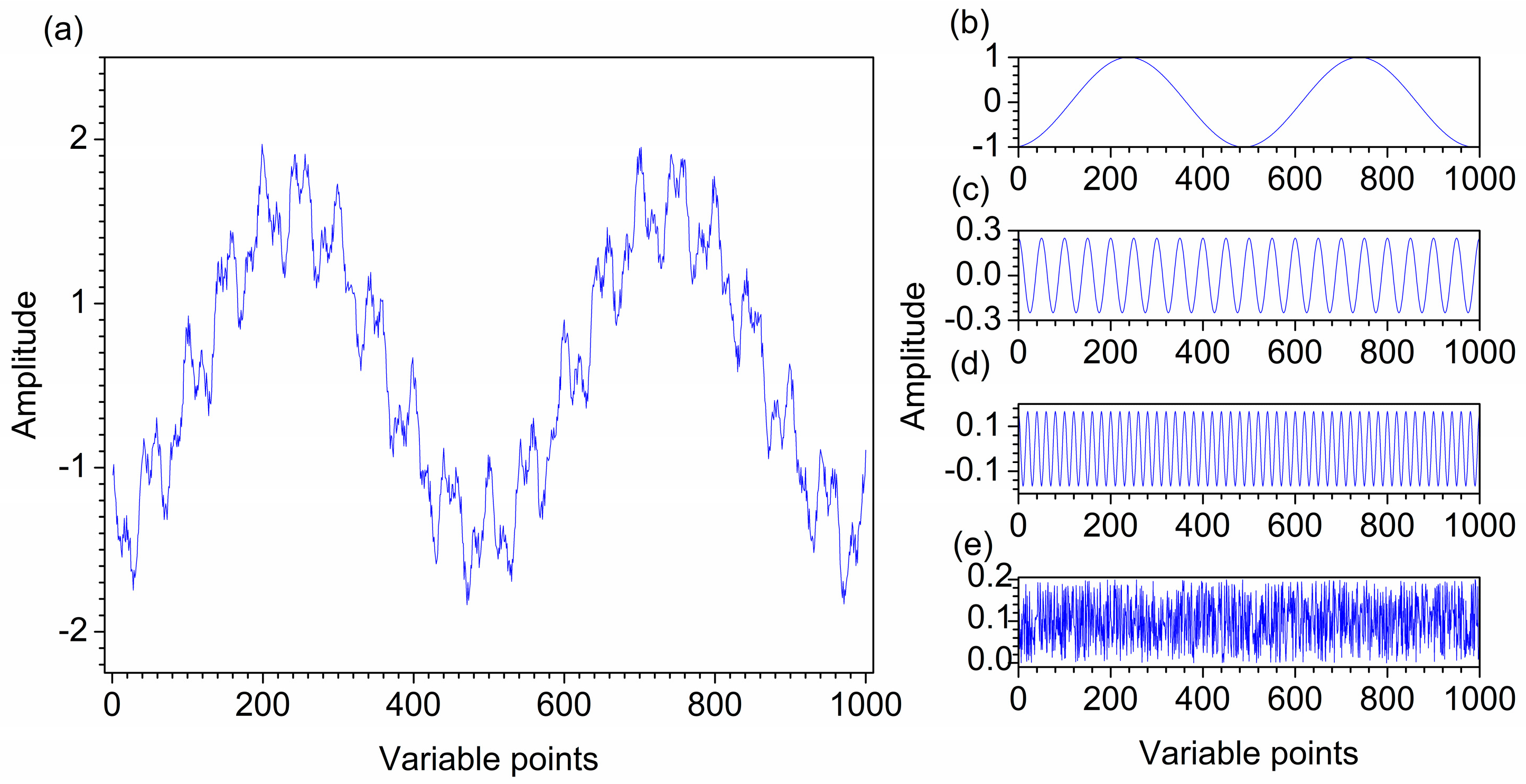

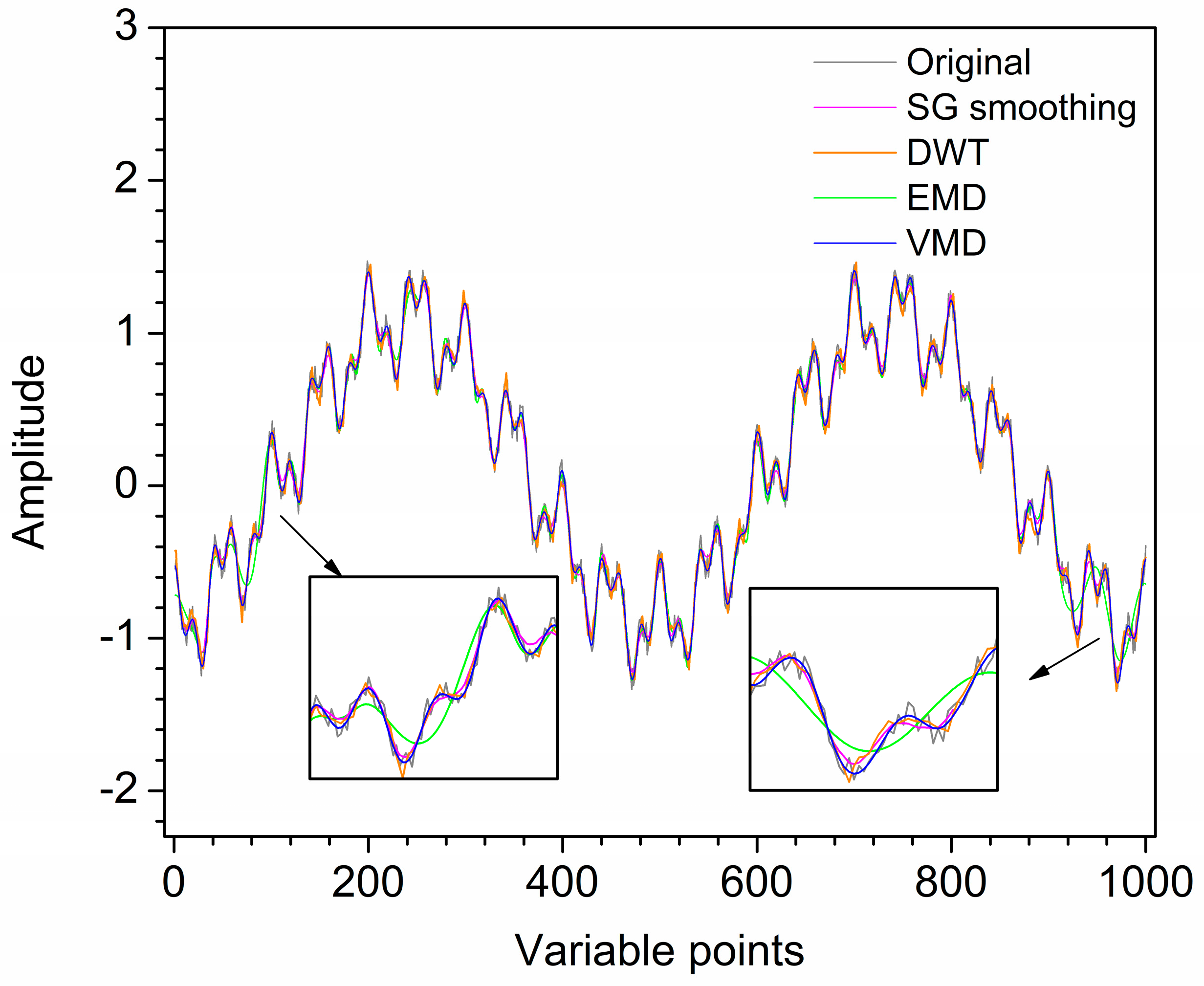
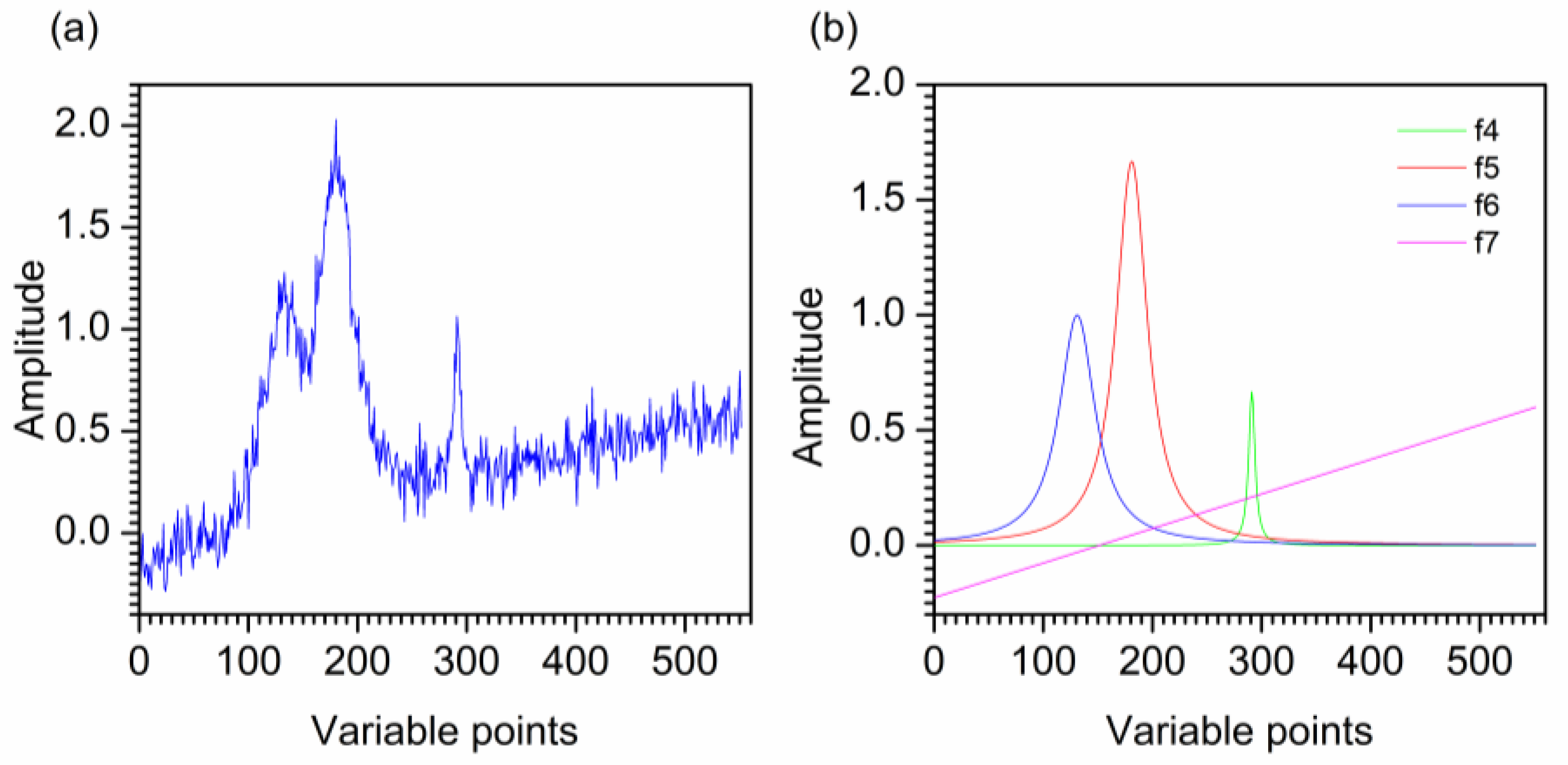
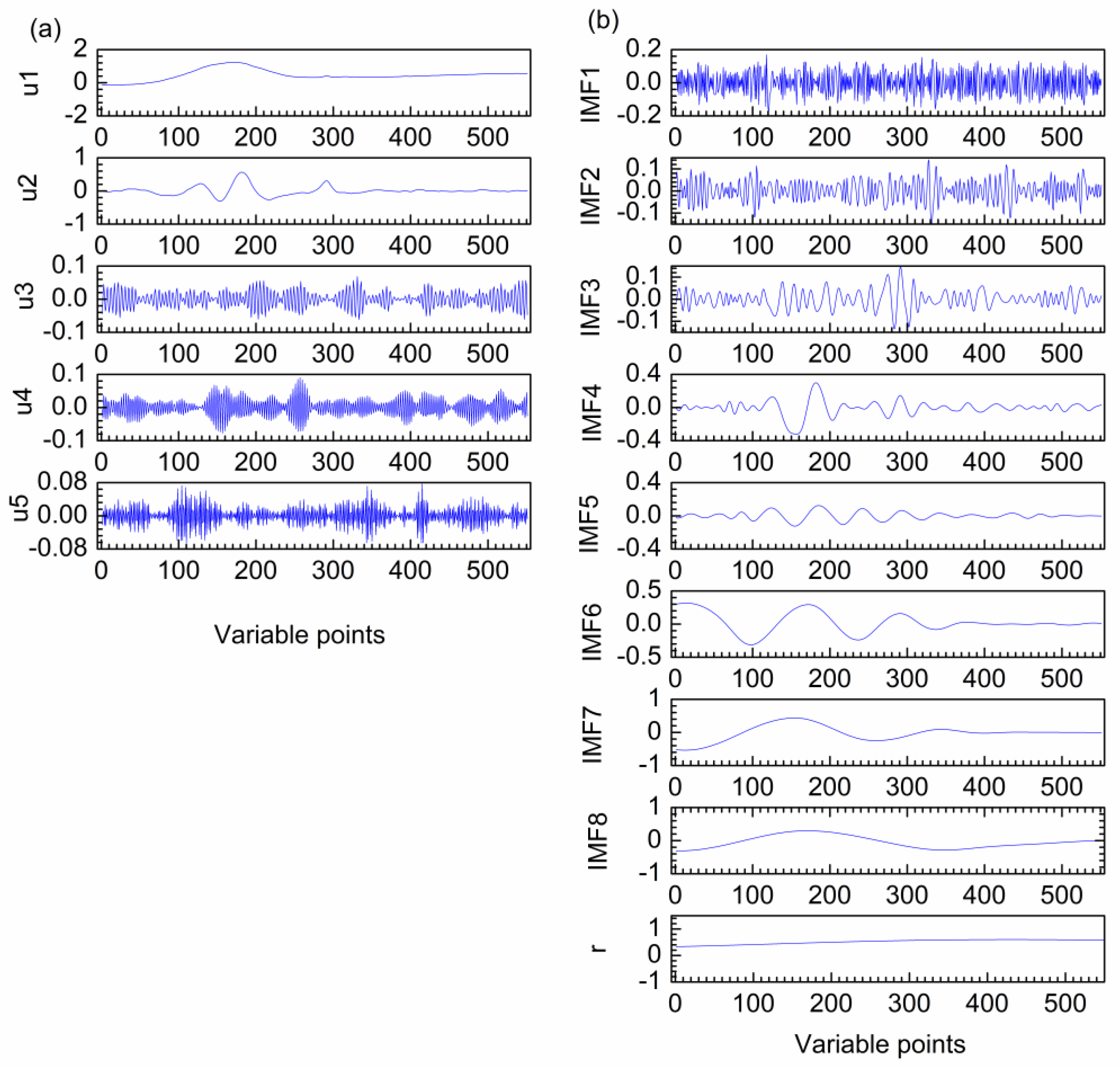
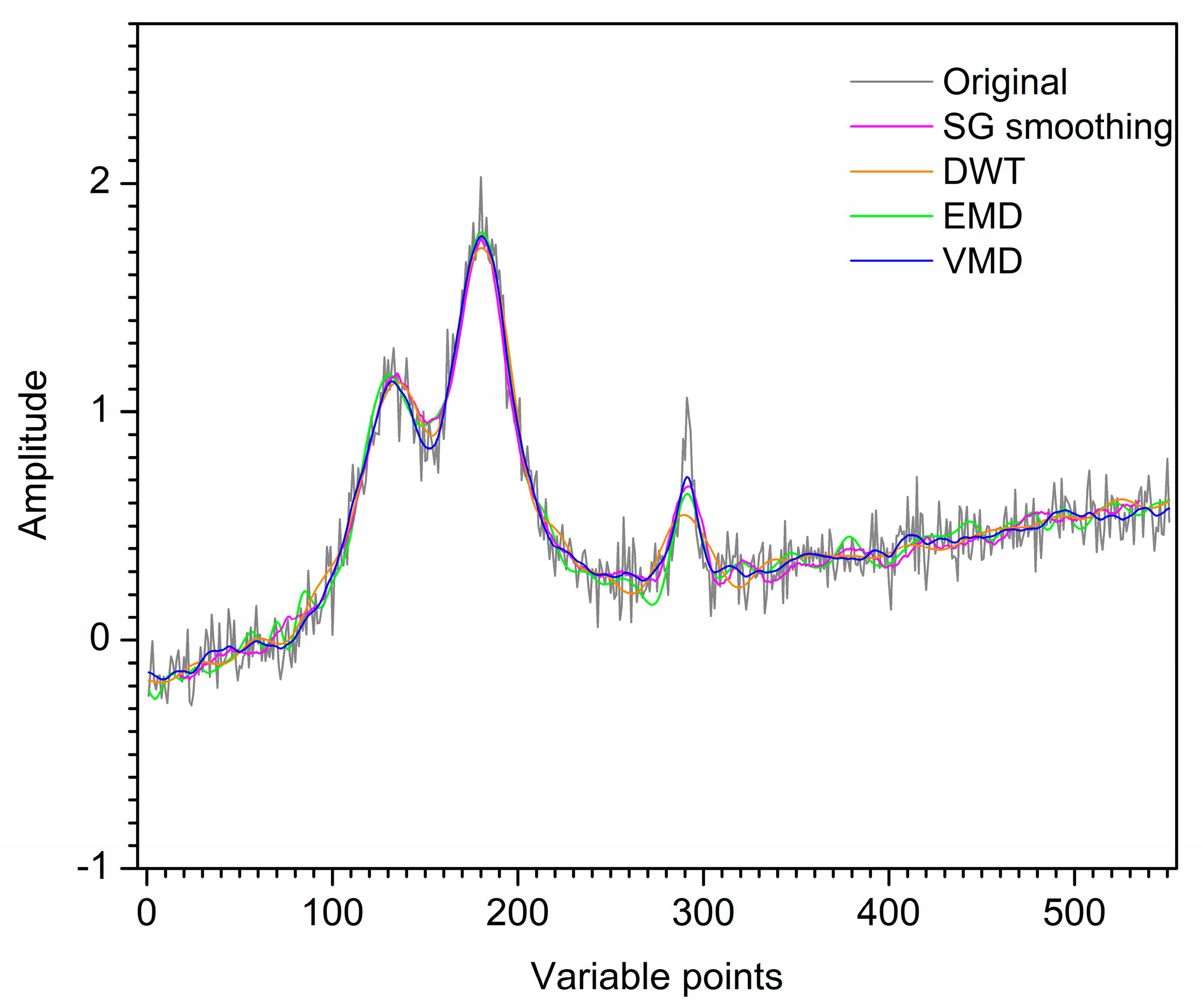
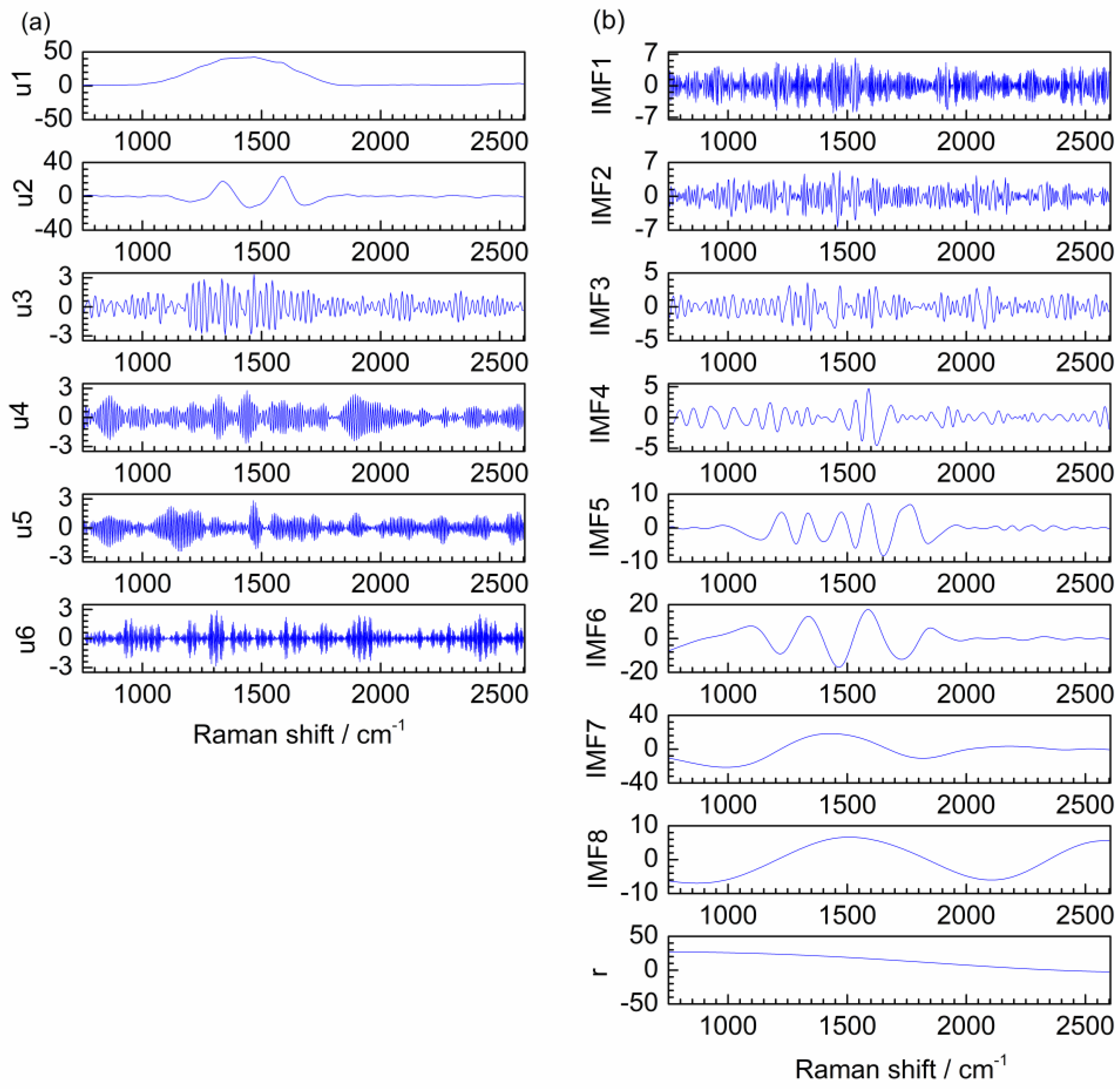
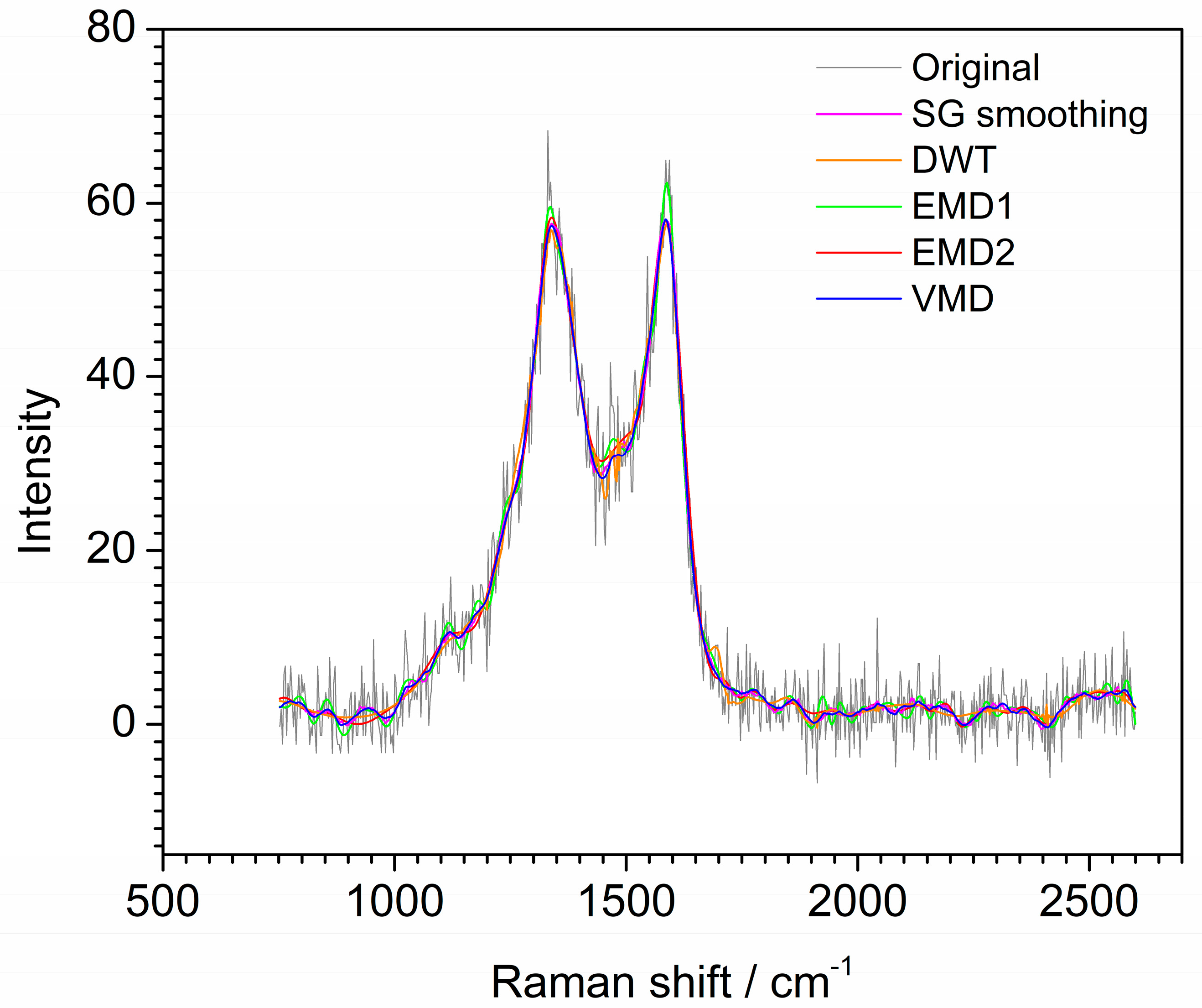

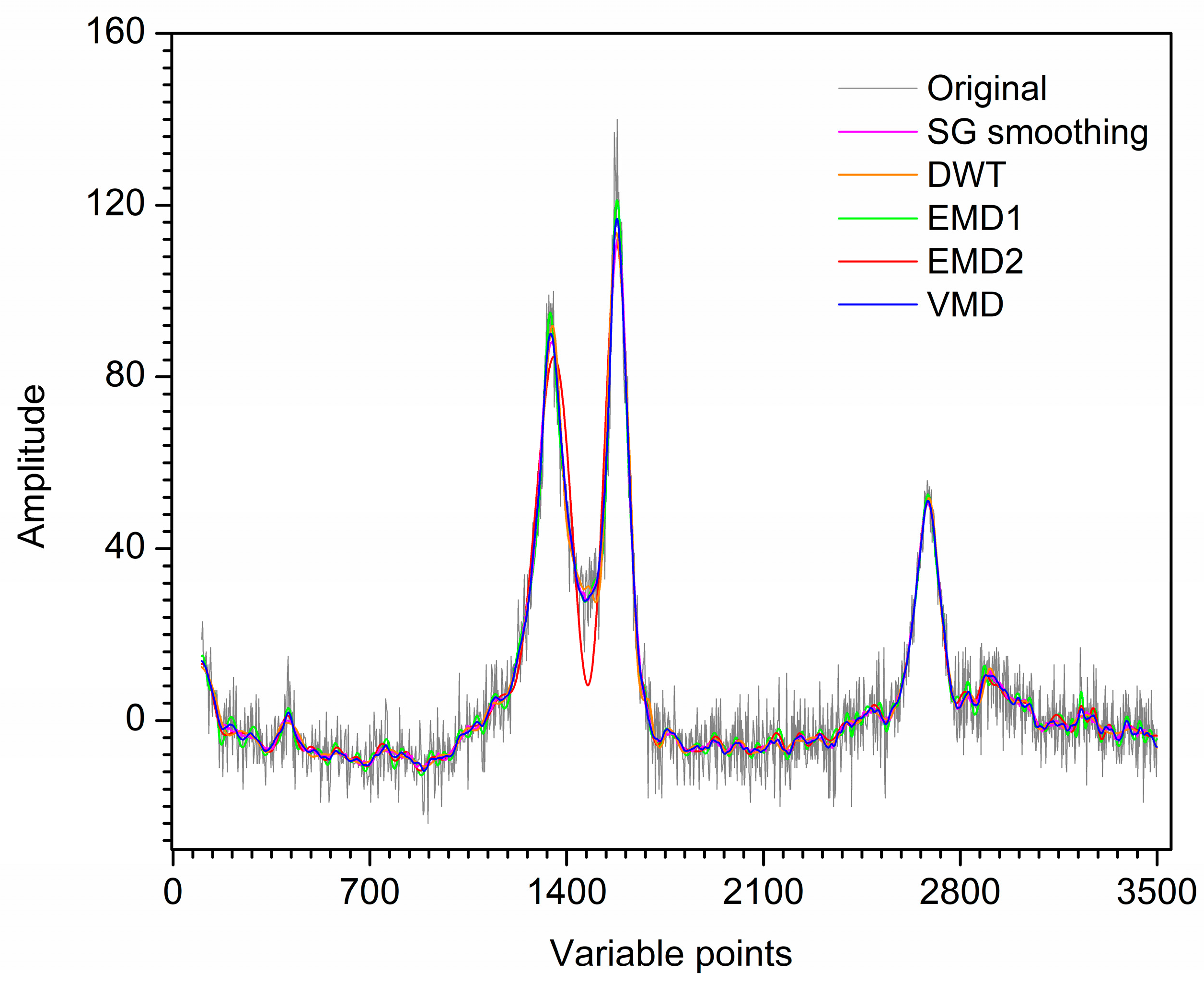
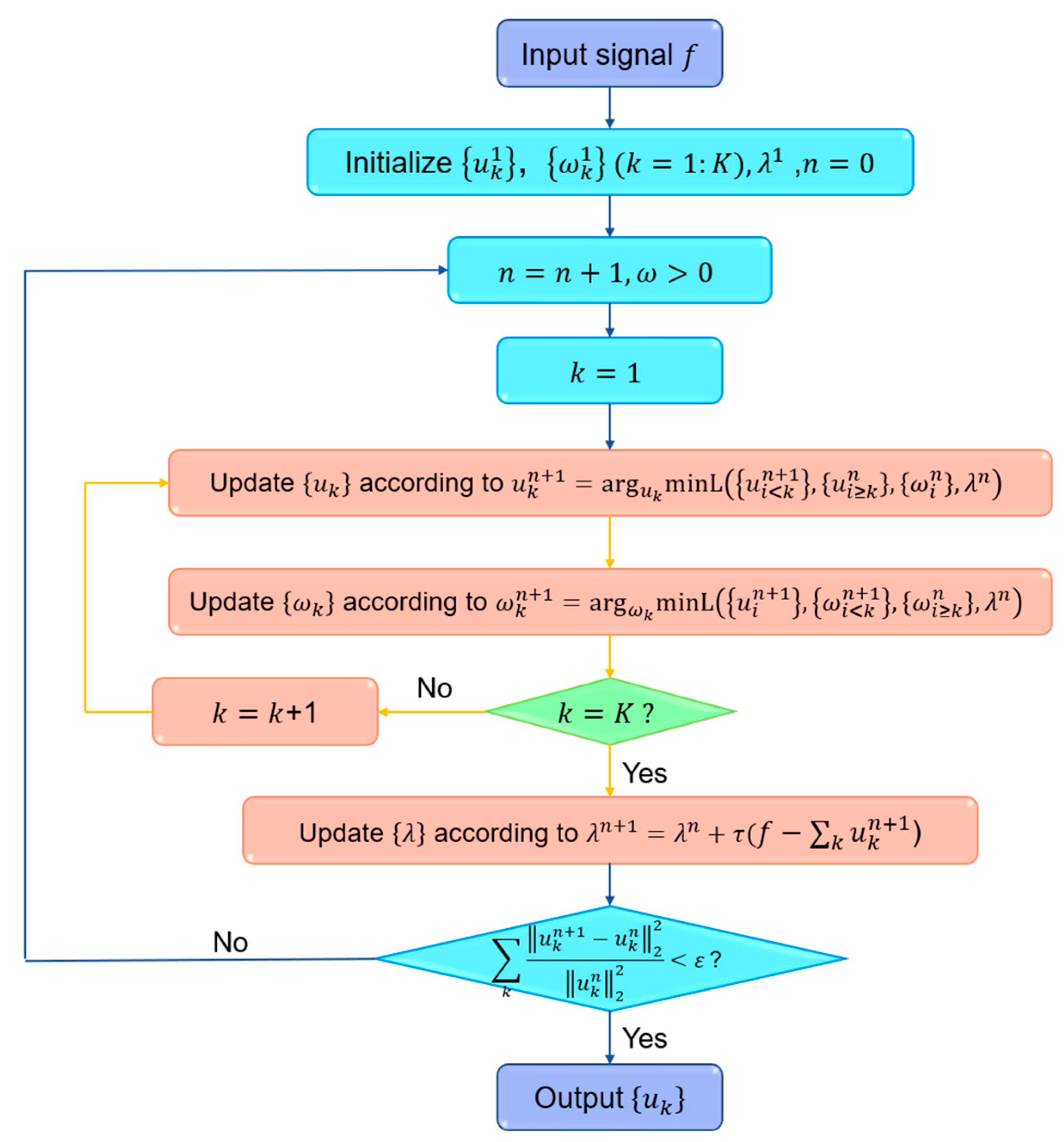
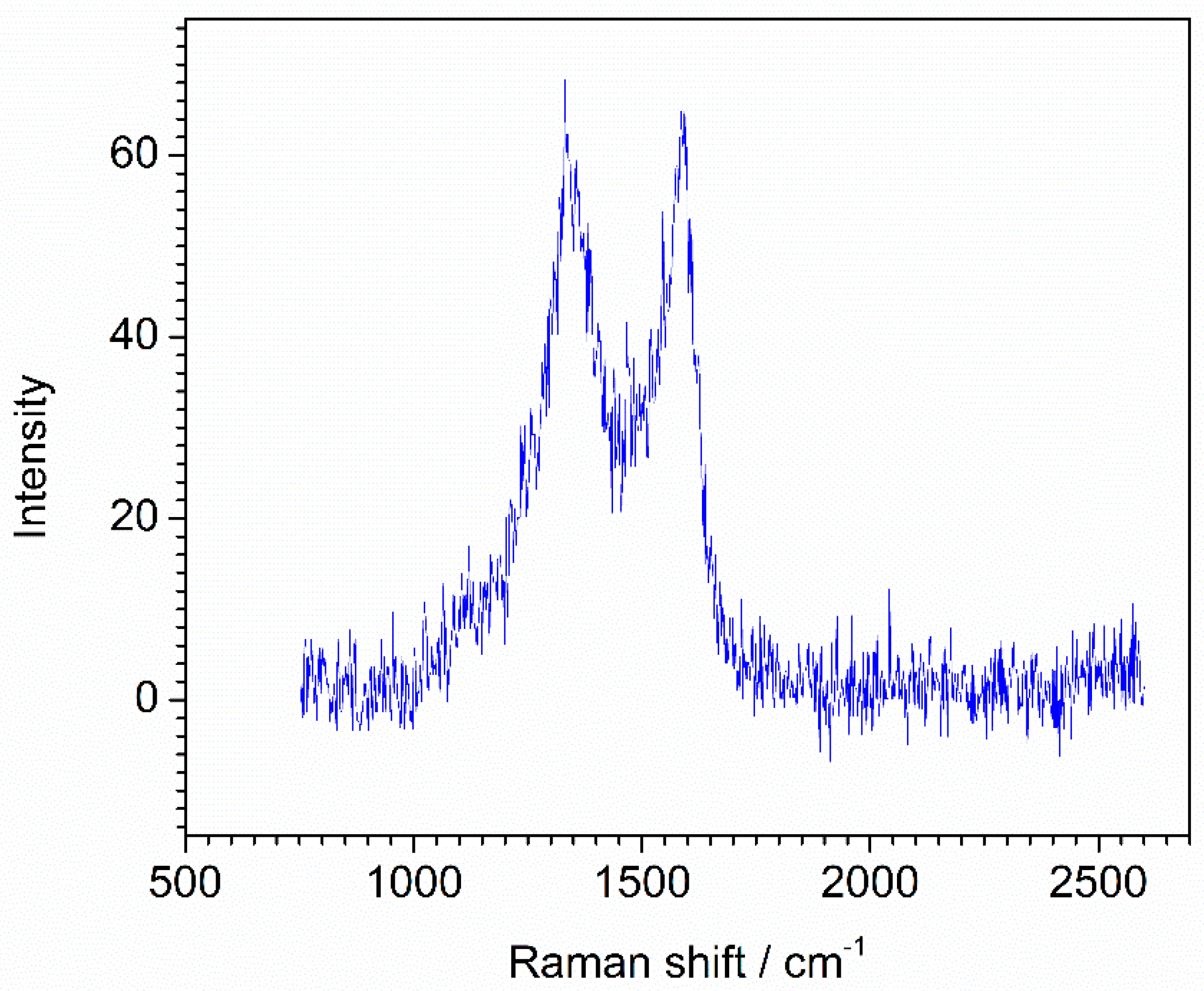
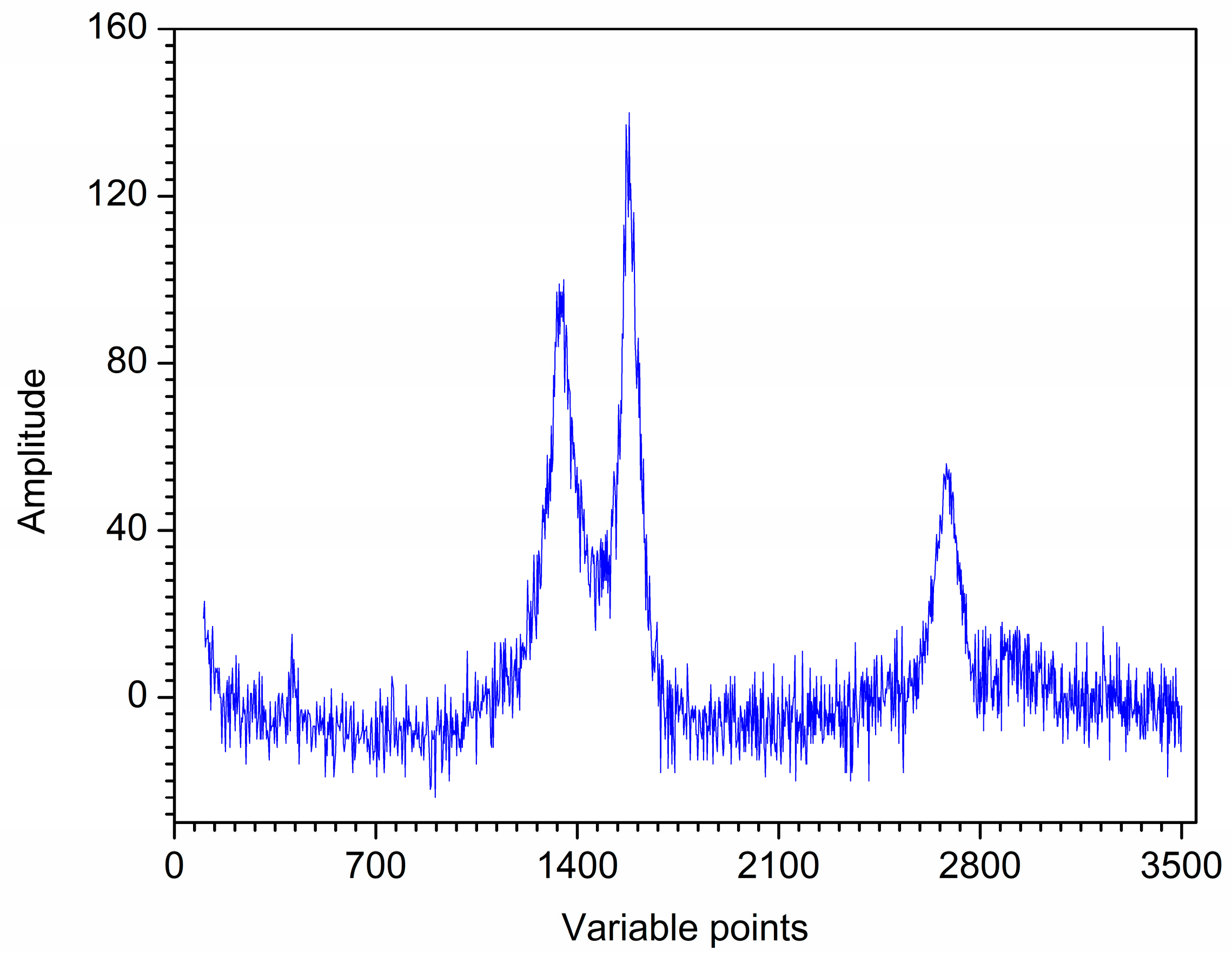
Disclaimer/Publisher’s Note: The statements, opinions and data contained in all publications are solely those of the individual author(s) and contributor(s) and not of MDPI and/or the editor(s). MDPI and/or the editor(s) disclaim responsibility for any injury to people or property resulting from any ideas, methods, instructions or products referred to in the content. |
© 2023 by the authors. Licensee MDPI, Basel, Switzerland. This article is an open access article distributed under the terms and conditions of the Creative Commons Attribution (CC BY) license (https://creativecommons.org/licenses/by/4.0/).
Share and Cite
Bian, X.; Shi, Z.; Shao, Y.; Chu, Y.; Tan, X. Variational Mode Decomposition for Raman Spectral Denoising. Molecules 2023, 28, 6406. https://doi.org/10.3390/molecules28176406
Bian X, Shi Z, Shao Y, Chu Y, Tan X. Variational Mode Decomposition for Raman Spectral Denoising. Molecules. 2023; 28(17):6406. https://doi.org/10.3390/molecules28176406
Chicago/Turabian StyleBian, Xihui, Zitong Shi, Yingjie Shao, Yuanyuan Chu, and Xiaoyao Tan. 2023. "Variational Mode Decomposition for Raman Spectral Denoising" Molecules 28, no. 17: 6406. https://doi.org/10.3390/molecules28176406
APA StyleBian, X., Shi, Z., Shao, Y., Chu, Y., & Tan, X. (2023). Variational Mode Decomposition for Raman Spectral Denoising. Molecules, 28(17), 6406. https://doi.org/10.3390/molecules28176406






